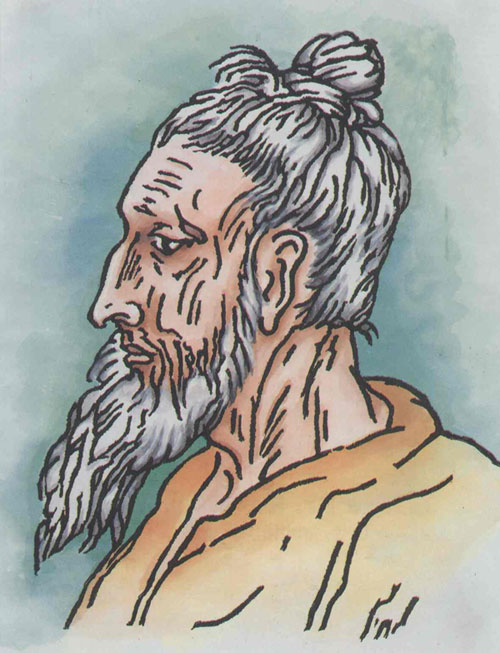
Professor Dr Anwarul Karim :
Lalon Shah (1774 (?)-17th October 1890) was a Sufi and Vaishnaba Baul. He is taken as the Rumi or the Hafiz of Bangladesh for his wonderful mystic songs. He is no more a regional poet of Bangladesh. The world has recognised the Baul cult as the World Heritage and Lalon, as the great Baul poet who influenced Rabindranath for his composition of Gitanjali, ‘Song offerings’ that earned him the Nobel Prize for Literature in 1913.
Kazi Nazrul Islam, our National poet, was also greatly influenced by him and composed many songs with Baul tune and Baul thought.
He was a religious leader (guru or mentor) of Baul community. He was a composer of Baul songs and also a noted performer or bayati (a folk religious singer). According to tradition, he was born in a village Kulbaria Harishpur, Thana Harinakundu, under Jhenidah district (formerly a subdivision of Jessore); and later came to Kushtia where he was known as Kayastha, a caste Hindu. Another record speaks of his birthplace at Bharara, under Chapra Union.
In his young age he was found unconscious by the side of Kaliganga river adjacent to Seuria village under Kumerkhali Upozila. Matijan Bibi, wife of one Malom Fakhir of the same village picked him up while she came to the river for fetching water and took him to her house. Later it was found that he had been suffering from small pox. Motijan and her husband cured him of his disease. Lalon did not disclose his identity for reasons known only to him and expressed his desire to stay with Malom’s family. Both Malom and Motijan were disciples of one Seraj Shah, a Sufi Faqir who belonged to Harishpur village of Harinakundu Thana of present Jhenidah district. Once when he came to the house of Malom Faqir, Seraj inducted Lalon to his cult. Since then, Lalon used to accompany him on most occasion. Molom being childless took Lalon as his foster child and arranged an Akhra or a religious resort within his property. Since then, Lalon lived there with a young girl, named Bishaka, who, he brought from an unknown place. She used to take care of Lalon and was treated by his followers as Guru Maa.
Lalon died at Seuria on October 17, 1890. Both Lalon and Bishaka were buried in the same place known today as Lalon Mazar. Lalon was known to the Tagore Estate at Shelaidah where the grandfather of Rabindranath Prince Dwarakanath Tagore established his zemindari estate during the British period. Rabindranath’s father Debendranath Tagore looked after the estate and zemindari. Many of the members of Tagore family of Jorashakon, Kolkata , including Jyotirindranath Tagore, an elder brother to Rabindranath who took over the management of the estate but finally, Debendranath asked Rabindranath to look after the estate in 1888-89. Lalon Faqir was known to the Tagore family at Shelaidah and it was Jyotirindranath Tagore who made a pencil sketch of Lalon Faqir on the Padma boat over the Ganges. Rabindranath Tagore heard of him when he came to Selaidah first with his father and next with his elder brother, Jyotirindranath Tagore. Lalon used to visit to the Tagore estate and performed songs with others. Rabindranath came to Seuria on a number of occasions. He collected many of Lalon’s songs, written in two khata (note book) personally. It is reported that he donated money to the construction of his grave.
Later in 1963, Lalon Folk Literature Centre was founded by local initiative led by Prof. Anwarul Karim, the researcher of the Baul poet Lalon Fakhir and help from the district Administration of Kushtia. Mr Q G the Deputy Commissioner, Kushtia set up a mausoleum on the Mazar of Lalon Faqir, built the entrance gate and a Folk Literature Centre. After independence a further improvement was made with the help of the government and local initiatives. Prof. Anwarul Karim, who was awarded a PhD degree on the Baul cult and Lalon Faqir, was made the Founder Director of Lalon Academy.
Lalon was a humanist and an iconoclast who rejected all distinctions of caste and creed. He was a Boyati, composer and performer of songs. During his life, he organized a three-day programme on a full moon night, Dol-Purnima, (birth date of Krishna) in the month of Falgun (March-April). After his death, his followers used to arrange program on October 17, and the first day of Bengali month Kartic. After Independence, the government of Bangladesh led by Prime Minister Sheikh Hasina, built a complex at Seuria. It has an auditorium, a library, an office and open space within the complex for the Bauls to stay as and when required. The government also built a performing stage over a vast open space beside the Academy. Thousands of Bauls come to the Mazar of Lalon Shah twice a year, one in Dol-Purnima and another in October, on the occasion of his death anniversary. During these three-day program tens of thousands come to the Lalon Mazar and pay rich tributes to Lalon Faqir.
Lalon Shah left no written records of his songs. His disciples and followers communicate his songs orally when they perform.
In Bengali culture Lalon Shah has become an icon of religious tolerance and secularism whose songs inspired and influenced many poets and social and religious thinkers, including Rabindranath Tagore and Kazi Nazrul Islam. He revolted against social custom and caste system and rejected all distinctions of caste and creed. He was non-communal, a humanist and an iconoclast who denounced caste and creed. n

